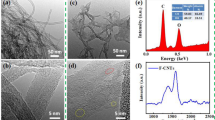Abstract
A concept for creating a future ultra-low-resistivity material based on a carbon nanotube–metal composite is presented. Using a simple effective-medium model it is shown that a room-temperature resistivity 50% lower than Cu is achievable. This article sets a goal for future R&D activities, although a number of technical as well as scientific problems are to be solved before realising the suggested concept. The ultra-low resistivity is possible because the ballistic conducting carbon nanotubes have an electron mean free path several orders of magnitude longer than metals like Cu and Ag. This implies that a system with parallel-connected tubes can indeed have a room-temperature resistivity far below the resistivity of conventional metal conductors like Al, Cu and Ag.
Similar content being viewed by others
References
See for example Physics World, June 2000, Special Issue ‘Carbon nanotubes roll on’ and references therein
C.T. White, T.N. Todorov: Nature 393, 240 (1998)
See for example S. Datta: Electronic Transport in Mesoscopic Systems (Cambridge University Press 1995)
J. Kong, E. Yenilmez, T.W. Tombler, W. Kim, H. Dai, R. Laughlin, L. Liu, C.S. Jayanthi, S.Y. Wu: Phys. Rev. Lett. 87, 10680 (2001)
J. Kong, H. Dai: to be published
S. Frank, P. Poncharal, Z.L. Wang, W.A. De Herr: Science 280, 1744 (1998)
P. Delaney: Appl. Phys. Lett. 75, 3787 (1999)
S. Sanvioto, Y.-K. Kwong, D. Tomanek, C.J. Lambert: Phys. Rev. Lett. 84, 1974 (2000)
P.L. McEuen, M. Bockrath, D.H. Cobden, Y.-G. Yoon, S.G. Louie: Phys. Rev. Lett. 83, 5098 (1999)
C. Dekker: Phys. Today, p. 22, May 1999
P.J.F. Harris: Carbon Nanotubes and Related Structures (Cambridge University Press 1999)
G. Grimvall: Thermophysical Properties of Materials, enlarged and revised edn. (Elsevier, Amsterdam 1999) Chap. 17
B. Ke-Da, L. Hui, G. Grimvall: Int. J. Heat Mass Transfer 36, 4033 (1993)
One obvious limitation of the effective-medium model is that scattering effects induced in the material due to the filler particles (CNTs) are not accounted for. For example, in a Cu–Ag alloy with 1% Ag the resistivity is increased by ∼20% due to the Ag impurities in the Cu matrix. The average distance between the Ag atoms in such an alloy is ∼1 nm. In a SWNT–metal composite with 10–50% filling of parallel SWNTs the average distance between the tubes (in a plane perpendicular to the tube directions) is 0.5–3 nm (i.e. the same order of distance as for the Cu–Ag(1%) alloy case). However, the lengths between the scattering centres in the direction parallel to the tubes (i.e. the conducting direction) are in the range of several μm. From these geometrical considerations we argue that the scattering effect in a CNT–metal composite should be much smaller compared to the scattering effects in the Cu–Ag(1%) alloy
H. Dai: Physics World, p. 43, June 2000
T.W. Ebbesen, P.M. Ajayan: Nature 358, 220 (1992)
H.T. Soh, C.F. Quate, A.F. Morpurgo, C.M. Marcus, J. Kong, H. Dai: Appl. Phys. Lett. 75, 627 (1999)
J. Kong, H.T. Soh, A.M. Cassell, C.F. Quate, H. Dai: Nature 395, 878 (1998)
Author information
Authors and Affiliations
Corresponding author
Additional information
PACS
72.15.-v; 81.05.Zx
Rights and permissions
About this article
Cite this article
Hjortstam, O., Isberg, P., Söderholm, S. et al. Can we achieve ultra-low resistivity in carbon nanotube-based metal composites?. Appl. Phys. A 78, 1175–1179 (2004). https://doi.org/10.1007/s00339-003-2424-x
Received:
Accepted:
Published:
Issue Date:
DOI: https://doi.org/10.1007/s00339-003-2424-x




